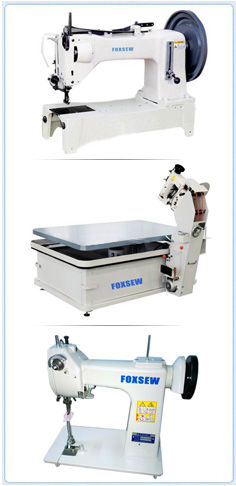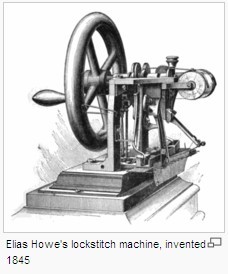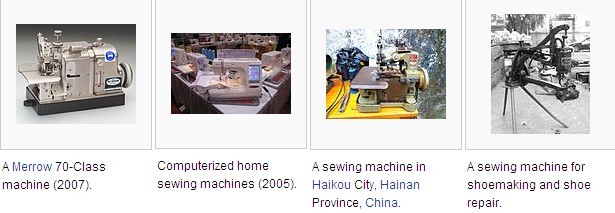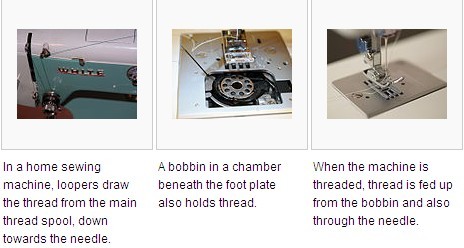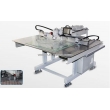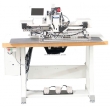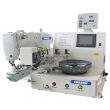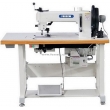A sewing machine is a machine used to stitch fabric and other materials together with thread. Sewing machines were invented during the first Industrial Revolution to decrease the amount of manual sewing work performed in clothing companies. Since the invention of the first working sewing machine, generally considered to have been the work of Englishman Thomas Saint in 1790,[1] the sewing machine has vastly improved the efficiency and productivity of fabric, clothing and needle industries.
Home sewing machines are designed for one person to sew individual items while using a single stitch type. Modern sewing machines are designed in such a way that the fabric easily glides in and out of the machine without the hassle of needles and thimbles and other such tools used in hand sewing, automating the process of stitching and saving time.
Industrial sewing machines, by contrast, are larger, faster, more complex, and more varied in their size, cost, appearance, and task.
The fabric shifting mechanism may be a workguide or may be pattern-controlled (e.g., jacquard type). Some machines can create embroidery-type stitches. Some have a work holder frame. Some have a workfeeder that can move along a curved path, while others have a workfeeder with a work clamp. Needle guards, safety devices to prevent accidental needle-stick injuries, are often found on modern sewing machines.
History and development
In 1790 English inventor Thomas Saint was the first to patent a design for a sewing machine but he did not advertise his invention.[2] It was meant for leather and canvas. It is likely that Saint had a working model but there is no evidence of one; he was a skilled cabinet maker and included many practically functional features: an overhanging arm, a feed mechanism (adequate for short lengths of leather), a vertical needle bar, and a looper. (In 1874 a sewing machine manufacturer, William Newton Wilson, found Saint's drawings in the London Patent Office, made adjustments to the looper, and built a working machine, currently owned by the London Science Museum.)
An Austrian tailor Josef Madersperger began developing the first sewing machine in 1807. He presented the first working machine in 1814. In 1830 Barthélemy Thimonnier, a French tailor, patented a sewing machine that sewed straight seams using chain stitch. By 1841, Thimonnier had a factory of 80 machines sewing uniforms for the French Army.[3] The factory was destroyed by rioting French tailors afraid of losing their livelihood. Thimonnier had no further success with his machine.
The first American lockstitch sewing machine was invented by Walter Hunt in 1832.[4] His machine used an eye-pointed needle (with the eye and the point on the same end) carrying the upper thread and a falling shuttle carrying the lower thread. The curved needle moved through the fabric horizontally, leaving the loop as it withdrew. The shuttle passed through the loop, interlocking the thread. The feed let the machine down, requiring the machine to be stopped frequently and reset up. Hunt eventually lost interest in his machine and sold it without bothering to patent it.
In 1842, John Greenough patented the first sewing machine in the United States. Elias Howe, born in Spencer, Massachusetts, created his sewing machine in 1845, using a similar method to Hunt's, except the fabric was held vertically. The major improvement he made was to have the needle running away from the point, starting from the eye. After a lengthy stint in England trying to attract interest in his machine he returned to America to find various people infringing his patent, among them Isaac Merritt Singer.[5] He eventually won a case against patent infringement in 1854 and was awarded the right to claim royalties from the manufacturers using ideas covered by his patent, including Singer.
Trained as an engineer, Singer saw a rotary sewing machine being repaired in a Boston shop. He thought it to be clumsy and promptly set out to design a better one. His machine used a falling shuttle instead of a rotary one; the needle was mounted vertically and included a presser foot to hold the cloth in place. It had a fixed arm to hold the needle and included a basic tensioning system. This machine combined elements of Thimonnier's, Hunt's, and Howe's machines. He was granted an American patent in 1851 and it was suggested he patent the foot pedal (or treadle) used to power some of his machines; however, it had been in use for too long for a patent to be issued. When Howe learned of Singer's machine he took him to court. Howe won and Singer was forced to pay a lump sum for all machines already produced. Singer then took out a license under Howe's patent and paid him $1.15 per machine. Singer then entered a joint partnership with a lawyer named Edward Clark. They established the first hire-purchase scheme to allow people to buy their machines through payments over time.
Meanwhile Allen B. Wilson had developed a shuttle that reciprocated ("vibrated") in a short arc, which was an improvement over Singer's and Howe's. However, John Bradshaw had patented a similar device and was threatening to sue. Wilson decided to try a new method. He went into partnership with Nathaniel Wheeler to produce a machine with a rotary hook instead of a shuttle. This was far quieter and smoother than the other methods, and the Wheeler and Wilson Company produced more machines in 1850s and 1860s than any other manufacturer. Wilson also invented the four-motion feed mechanism; this is still seen on every machine today. This had a forward, down, back, and up motion, which drew the cloth through in an even and smooth motion. Charles Miller patented the first machine to stitch buttonholes.[6] Through the 1850s more and more companies were being formed and were trying to sue each other. This triggered a patent thicket known as the Sewing Machine War.[7]
In 1856 the Sewing Machine Combination was formed, consisting of Singer, Howe, Wheeler, Wilson, Grover and Baker. These four companies pooled their patents, meaning that all the other manufacturers had to obtain a license and pay $15 per machine. This lasted until 1877 when the last patent expired.
James Edward Allen Gibbs (1829–1902), a farmer from Raphine in Rockbridge County, Virginia patented the first chain-stitch single-thread sewing machine on June 2, 1857. In partnership with James Willcox, Gibbs became a principal in Willcox & Gibbs Sewing Machine Company. Willcox & Gibbs commercial sewing machines are still used in the 21st century.
Clothing manufacturers were the first sewing machine customers, and used them to produce the first ready-to-wear clothing and shoes. In the 1860s consumers began purchasing them, and the machines—ranging in price from £6 to £15 in Britain depending on features—became very common in middle-class homes. Owners were much more likely to spend free time with their machines to make and mend clothing for their families than to visit friends, and women's magazines and household guides such as Mrs Beeton's offered dress patterns and instructions. A sewing machine could produce a man's shirt in about one hour, compared to 14 1/2 hours by hand.[8]
In 1877 the world’s first crochet machine was invented and patented by Joseph M. Merrow, then-president of what had started in the 1840s as a machine shop to develop specialized machinery for the knitting operations. This crochet machine was the first production overlock sewing machine. The Merrow Machine Company went on to become one of the largest American Manufacturers of overlock sewing machines, and continues to be a global presence in the 21st century as the last American over-lock sewing machine manufacturer.
In 1885 Singer patented the Singer Vibrating Shuttle sewing machine, which used Allen B. Wilson's idea for a vibrating shuttle and was a better lockstitcher than the oscillating shuttles of the time. Millions of the machines, perhaps the world's first really practical sewing machine for domestic use, were produced until finally superseded by rotary shuttle machines in the 20th century. Sewing machines continued being made to roughly the same design, with more lavish decoration appearing until well into the 1900s.
In 1905 Merrow won a lawsuit against Willcox & Gibbs for the rights to the original crochet stitch.
The first electric machines were developed by Singer Sewing Co. and introduced in 1889.[9] At first these were standard machines with a motor strapped on the side. As more homes gained power, these became more popular and the motor was gradually introduced into the casing.
Stitch formation
Sewing machines can make a great variety of plain or patterned stitches. Ignoring strictly decorative aspects, over three dozen distinct stitch formations are formally recognized by the ISO 4915:1991 standard, involving one to seven separate threads to form the stitch.[10] Plain stitches fall into four general categories: lockstitch, chainstitch, overlock, and coverstitch.
Lockstitch
Lockstitch is the familiar stitch performed by most household sewing machines and most industrial "single needle" sewing machines from two threads, one passed through a needle and one coming from a bobbin or shuttle. Each thread stays on the same side of the material being sewn, interlacing with the other thread at each needle hole by means of a bobbin driver. As a result, a lockstitch can be formed anywhere on the material being sewn; it does not need to be near an edge.
Chainstitch
Chainstitch was used by early sewing machines and has 2 major drawbacks:
The stitch is not self-locking, and if the thread breaks at any point or isn't tied at both ends, the whole length of stitching comes out. It's also easily ripped out.
The direction of sewing can't be changed much from one stitch to the next, or the stitching process fails.
People soon realized a better stitch was needed, and it was found in the lockstitch. The chainstitch is still used today in clothing manufacture, though due to its major drawback it is generally paired with an overlock stitch along the same seam.
Overlock
Overlock, also known as "serging" or "serger stitch", can be formed with one to four threads, one or two needles, and one or two loopers. Overlock sewing machines are usually equipped with knives that trim or create the edge immediately in front of the stitch formation. Household and industrial overlock machines are commonly used for garment seams in knit or stretchy fabrics, for garment seams where the fabric is light enough that the seam does not need to be pressed open, and for protecting edges against raveling. Machines using two to four threads are most common, and frequently one machine can be configured for several varieties of overlock stitch. Overlock machines with five or more threads usually make both a chainstitch with one needle and one looper, and an overlock stitch with the remaining needles and loopers. This combination is known as a "safety stitch". Household overlock machines are widely used.
Coverstitch
Coverstitch is formed by two or more needles and one or two loopers. Like lockstitch and chainstitch, coverstitch can be formed anywhere on the material being sewn. One looper manipulates a thread below the material being sewn, forming a bottom cover stitch against the needle threads. An additional looper above the material can form a top cover stitch simultaneously. The needle threads form parallel rows, while the looper threads cross back and forth all the needle rows. Coverstitch is so-called because the grid of crossing needle and looper threads covers raw seam edges, much as the overlock stitch does. It is widely used in garment construction, particularly for attaching trims and flat seaming where the raw edges can be finished in the same operation as forming the seam.
Feed mechanisms
Besides the basic motion of needles, loopers and bobbins, the material being sewn must move so that each cycle of needle motion involves a different part of the material. This motion is known as feed, and sewing machines have almost as many ways of feeding material as they do of forming stitches. For general categories, we have: drop feed, needle feed, walking foot, puller, and manual. Often, multiple types of feed are used on the same machine. Besides these general categories, there are also uncommon feed mechanisms used in specific applications like edge joining fur, making seams on caps, and blindstitching.
Drop feed
The drop feed mechanism is used by almost all household machines and involves a mechanism below the sewing surface of the machine. When the needle is withdrawn from the material being sewn, a set of "feed dogs" is pushed up through slots in the machine surface, then dragged horizontally past the needle. The dogs are serrated to grip the material, and a "presser foot" is used to keep the material in contact with the dogs. At the end of their horizontal motion, the dogs are lowered again and returned to their original position while the needle makes its next pass through the material. While the needle is in the material, there is no feed action. Almost all household machines and the majority of industrial machines use drop feed. Differential feed is a variation of drop feed with two independent sets of dogs, one before and one after the needle. By changing their relative motions, these sets of dogs can be used to stretch or compress the material in the vicinity of the needle. This is extremely useful when sewing stretchy material, and overlock machines (heavily used for such materials) frequently have differential feed.
Needle feed
A needle feed, used only in industrial machines, moves the material while the needle is in the material. In fact, the needle may be the primary feeding force. Some implementations of needle feed rock the axis of needle motion back and forth, while other implementations keep the axis vertical while moving it forward and back. In both cases, there is no feed action while the needle is out of the material. Needle feed is often used in conjunction with a modified drop feed, and is very common on industrial two needle machines. The advantage of needle feed over drop feed is that multiple layers of material, especially slippery material, can not slide with respect to one another, since the needle holds all layers together while the feed action takes place. Household machines do not use needle feed as a general rule.
Walking foot
A walking foot replaces the stationary presser foot with one that moves along with whatever other feed mechanisms the machine already has. As the walking foot moves, it shifts the workpiece along with it.
Puller feed
Some factory machines and a few household machines are set up with an auxiliary puller feed, which grips the material being sewn (usually from behind the needles) and pulls it with a force and reliability usually not possible with other types of feed. Puller feeds are seldom built directly into the basic sewing machine. Their action must be synchronized with the needle and feed action built into the machine to avoid damaging the machine. Pullers are also limited to straight seams, or very nearly so. Despite their additional cost and limitations, pulling feeds are very useful when making large heavy items like tents and vehicle covers.
Manual feed
A manual feed is used primarily in freehand embroidery, quilting, and shoe repair. With manual feed, the stitch length and direction is controlled entirely by the motion of the material being sewn. Frequently some form of hoop or stabilizing material is used with fabric to keep the material under proper tension and aid in moving it around. Most household machines can be set for manual feed by disengaging the drop feed dogs. Most industrial machines can not be used for manual feed without actually removing the feed dogs.
Sewing machine needle
Sewing machines use special needles tailored to their needs and to the character of the material being sewn.



